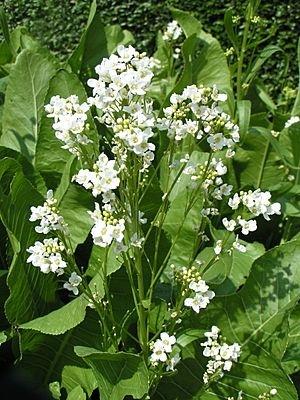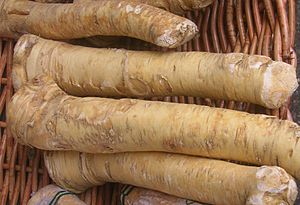Horseradish facts for kids
Quick facts for kids Horseradish |
|
|---|---|
 |
|
| Scientific classification | |
| Kingdom: | |
| (unranked): | |
| (unranked): | |
| (unranked): | |
| Order: | |
| Family: | |
| Genus: |
Armoracia
|
| Binomial name | |
| Armoracia rusticana |
|
Horseradish (Armoracia rusticana) is a perennial plant. This means it lives for more than two years. It belongs to the Brassicaceae family, which also includes plants like cabbage and mustard. Horseradish likely comes from southeastern Europe and western Asia. It can grow up to 1.5 meters (5 feet) tall. People mostly grow it for its large, white, tapered root.
The fresh horseradish root doesn't have much smell. But when you cut or grate it, special chemicals called enzymes are released. These enzymes break down a substance called sinigrin. This creates something called allyl isothiocyanate, also known as mustard oil. This mustard oil is what makes your sinuses and eyes tingle! If you grate horseradish, you need to mix it with vinegar quickly. If you don't, it can become very bitter.
Contents
History of Horseradish
Horseradish has been grown and used for a very long time. Some stories say that the Oracle of Delphi told the god Apollo that horseradish was worth its weight in gold. People in Egypt knew about horseradish as early as 1500 BC. During the Middle Ages, both the root and leaves were used as medicine. Later, it became a popular condiment (a sauce or spice) for meats in Germany, Scandinavia, and Britain. It came to North America when the first European settlers arrived.
The word horseradish has been used in English since the 1590s.
How Horseradish Grows
Horseradish is a perennial plant in many places. This means it grows back year after year. In colder areas, it can be grown as an annual, meaning it lives for only one year. After the first frost in autumn, the leaves die. Then, the root is dug up and split. The main root is used for cooking. One or more large pieces of the root are replanted. These pieces will grow into new plants for the next year.
If you leave horseradish alone in a garden, it can spread very easily. It grows through underground shoots. This can make it an invasive plant. Older roots left in the ground become hard and woody. They are no longer good for cooking. You can dig up older plants and divide them to start new ones.
Common Pests of Horseradish
One common pest for horseradish plants is the larva of the Pieris rapae butterfly. These larvae are also known as cabbageworms. The adult butterflies are white with black spots. You can often see them flying around the plants during the day. The caterpillars are velvety green with faint yellow stripes. When fully grown, they are about 2.5 centimeters (1 inch) long. They move slowly if you touch them.
These caterpillars chew large, ragged holes in the leaves. They usually leave the main veins of the leaves untouched. You can control them by simply picking them off the plants by hand.
Cooking with Horseradish
When cooks talk about "horseradish" or "prepared horseradish," they mean the grated root mixed with vinegar. Prepared horseradish is usually white or creamy-beige. It can last for months in the refrigerator. However, it will eventually turn darker, which means it's losing its flavor. The leaves of the plant can be eaten, but they are not as common. They are called "horseradish greens."
Horseradish Sauce
Horseradish sauce is made from grated horseradish root and vinegar. It is a very popular condiment. In the UK, it's often served with roast beef. It can also be used in sandwiches or salads. A similar sauce in Germany is called Tafelmeerrettich. It might use lemon juice instead of vinegar.
Another popular sauce in the UK is Tewkesbury mustard. This is a mix of mustard and grated horseradish. It has been around since medieval times. Even Shakespeare mentioned it in his plays! In the U.S., "horseradish sauce" often means grated horseradish mixed with mayonnaise or salad dressing. It's also a common ingredient in Bloody Mary drinks and cocktail sauce.
The strong, spicy taste of horseradish comes from a chemical called allyl isothiocyanate. When you crush the horseradish root, an enzyme called myrosinase is released. This enzyme acts on other substances in the plant, which then create the allyl isothiocyanate. This chemical actually helps the plant protect itself from animals that might try to eat it. Because allyl isothiocyanate doesn't last long, horseradish sauces lose their strong taste over time. That's why freshly grated horseradish is always the most pungent!
Horseradish as a Vegetable
In Central and Eastern Europe, horseradish is often called khreyn (or kren). There are two main types of khreyn. "Red" khreyn is mixed with red beet (beetroot). "White" khreyn has no beet. It is very popular in countries like Ukraine, Poland, Russia, and Hungary. Eating horseradish is also a part of Christian Easter and Jewish Passover traditions in these regions. For example, Ashkenazi Jews often serve beet horseradish with gefilte fish.
Horseradish can also be used as a main ingredient in soups. In the Silesia region of Poland, horseradish soup is a common dish for Easter Day.
Horseradish and Wasabi
The Japanese condiment wasabi is traditionally made from the wasabi plant. However, the wasabi plant is quite rare. So, most wasabi you find today is actually made with horseradish! The Japanese name for horseradish is seiyōwasabi, which means "Western wasabi." Both plants are part of the same plant family, Brassicaceae.
Health Benefits of Horseradish
Horseradish contains compounds that can be good for your health. It has special oils, like mustard oil, which can help fight bacteria. The fresh plant also has a good amount of vitamin C. For every 100 grams of raw horseradish, there's about 79.31 mg of vitamin C. A special enzyme found in the plant, called horseradish peroxidase (HRP), is used a lot in science, especially in molecular biology and biochemistry research.
Other pages
Images for kids
-
A bottle of Heinz horseradish sauce
See also
 In Spanish: Rábano rusticano para niños
In Spanish: Rábano rusticano para niños








